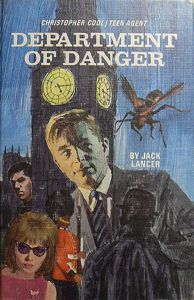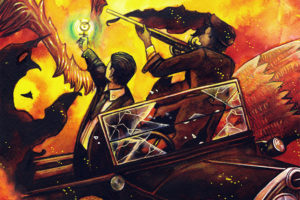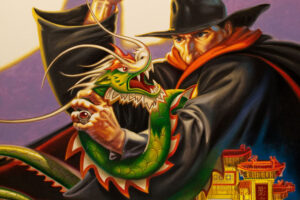 The ’60s spy crazy spawned a lot of things, good and bad. We had a lot of spy novels, movies, and TV shows that came out of it. It influenced other things, hence getting a novel series from Belmont and a comic-book series from Archie that made The Shadow more a spy, and a new Nick Carter series that was more a counterspy character than a detective.
The ’60s spy crazy spawned a lot of things, good and bad. We had a lot of spy novels, movies, and TV shows that came out of it. It influenced other things, hence getting a novel series from Belmont and a comic-book series from Archie that made The Shadow more a spy, and a new Nick Carter series that was more a counterspy character than a detective.
The juvenile book series mainly had spies and foreign agents as opponents that their heroes had to deal with. But there was one where the heroes were actual spies: Christopher Cool and his fellow teenage agents of T.E.E.N.
Created by the Stratemeyer Syndicate and published by Grosset & Dunlap, the series ran six volumes from 1967 to ’69. The series ended when I was too young to read it, and I only later discovered it through websites dedicated to various juvenile series.
Credited to “Jack Lancer,” the series was really written by Jim Lawrence, who had written the bulk of the Tom Swift Jr. series and would go on to write the long-running James Bond comic-strip series in the U.K. for a period of time.
The series consists of:
- X Marks the Spy (1967)
- Mission: Moonfire (1967)
- Department of Danger (1967)
- Ace of Shadows (1967)
- Heads You Lose (1968)
- Trial by Fury (1969)
The series had Chris and a group of other teen spies working for T.E.E.N. (Top-Secret Educational Espionage Network), headed by “Q.” All were in college and traveled overseas on their missions (London, France, Turkey, etc). Their main opponent was TOAD (a possible nod to U.N.C.L.E.’s opponent Thrush?), an international criminal group. I’m not sure if they explained what the name stood for.
The main characters are Chris and his roommate and partner Geronimo Johnson, an Apache Indian. They were sophomores at the fictional Ivy League Kingston College. Other T.E.E.N. agents who showed up in the series, only for short appearances, included Spice Carter, a student at Vassar University; Yummi Toyama, a Japanese-American student at Berklee College of Music; and Beauregard Tatum, an African-American student at Harvard. It’s interesting the main characters went to a fictional college, but the secondary characters went to real ones.
As is typical of spy-fi, we have gadgets like a pen that shoots anesthetic darts, earrings that shoot dazzling lights, etc.
The one volume I read was pretty good. Yes, there was an element of the fantastic in their opponents and such, but this was the same level you saw in James Bond or The Man from U.N.C.L.E. I’m still working to complete my set, but if you like spy-fi, check out this one.




I received the following from researcher James D. Keeline:
You mention that Jim Lawrence was the writer.
This is mostly true. He planned the series and wrote the first three volumes which were published in 1967. He had a disagreement with the Stratemeyer Syndicate that caused him to stop writing for them for many years.
The Syndicate auditioned several more writers and had two write the remaining volumes from the series. Jerrold Mundis, who had been working on the Hardy Boys, wrote two of them (4, 5). Volume 6 was written by Richard Deming.
In all cases the stories of this era were written from detailed outlines that were provided by the Syndicate. Even if Jim Lawrence wrote his own outline, it would be approved by the Syndicate, particularly Andrew E. Svenson who managed the boys’ series in this period and until his death in 1975.
Sales of this series were rather weak. Indeed, the royalties from the publisher never earned back the amount provided to the writer of each volume. A letter to Deming promises $2,000 for the work. The books were only actively sold for a couple years. But including the latest available royalty statement, the total sales for this volume was just $207.00, about 1/10 what he was paid. Indeed, none of the volumes recovered the amounts paid to writers in the 1967-1977 period for which data is available.
My main reason to write is to clarify the authorship. Sometimes people, including librarians, learn one name associated with a pen name or series and develop an assumption that the person wrote all of them. This is a mistake for series like the ones that were produced by the Stratemeyer Syndicate.
I have been studying the history of series books since 1988. Since 1992 I have been working on a Series Book Encyclopedia. I also give annual presentations to the Popular Culture Association national conferences.
James D. Keeline
https://Stratemeyer.org
James D. Keeline
James@Keeline.com